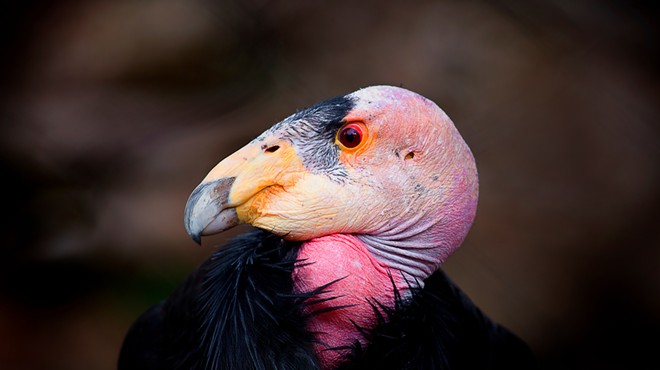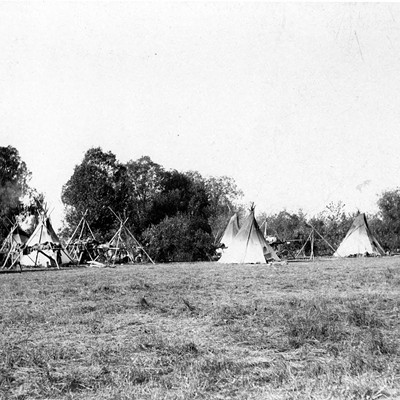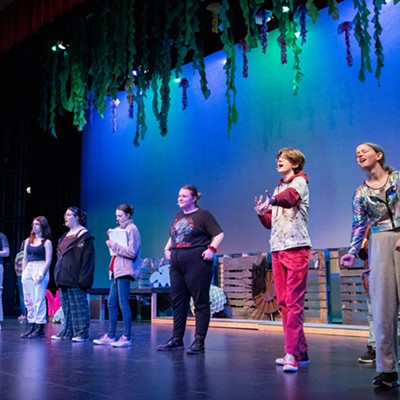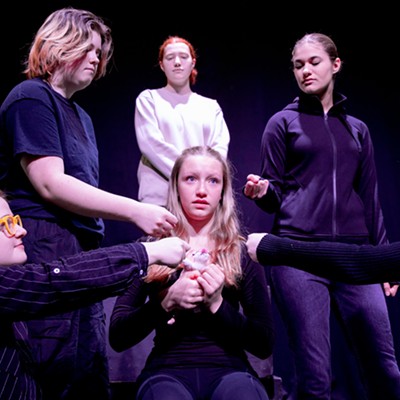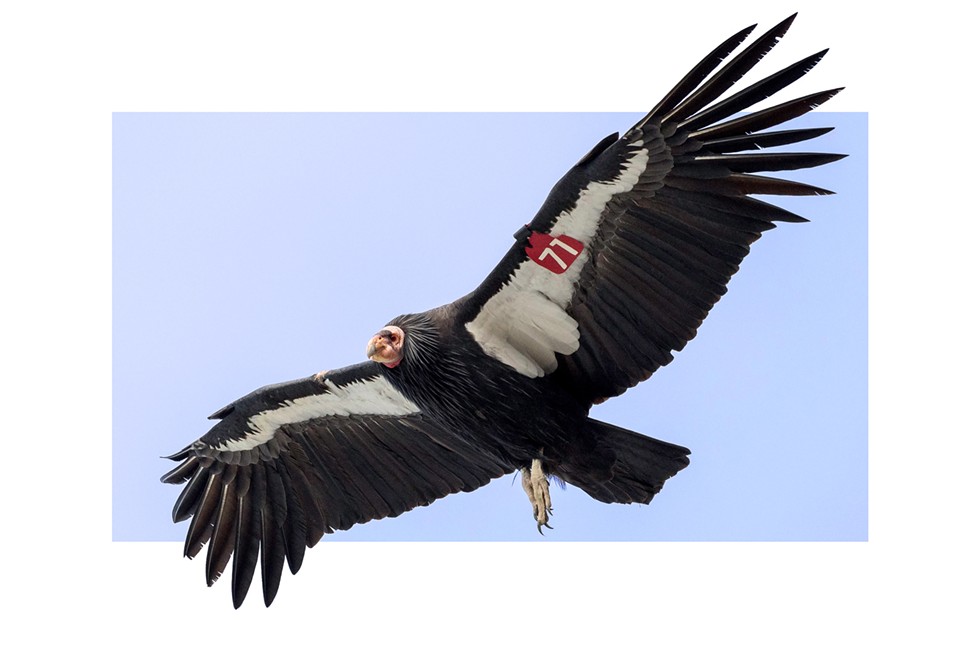
At sunrise on a fall day in 1897, the morning train from Coulee City to Spokane departed on schedule. C. Hart Merriam rode with a field notebook in his lap, noting the bright yellow flowers of blazing star that still bloomed among the sage and bitterbrush of the shrub-steppe. He tracked ridges of scabland basalt across the countryside, then waited patiently as the train stopped in small towns to pick up carloads of sacked wheat as well as crates of produce to sell farther east.
Merriam, whose friends called him Clint, was riding all the way to Spokane and eventually Washington, D.C. He and his sister Florence had grown up in New York state and were both accomplished naturalists from an early age. As young adults, they had developed a love of bird life and a taste for the American West. Clint had built on that background to rise to the position of director of the U.S. Biological Survey. Florence, for her part, was in that year working with a host of local correspondents on one of the first popular bird guides to our region, A Handbook of Birds of the Western United States.
Clint had spent the summer censusing mammals along the Cascade crest, and season's end found him reveling in open ponderosa parklands of the Okanogan before traversing the Waterville Plateau. The previous day, Sept. 28, he'd climbed out of Grand Coulee and taken lodgings in Coulee City.
That morning on the rolling train, Merriam kept his eyes open for birds. His count included magpies and meadowlarks, a single kingfisher, and numerous sparrow hawks watching for movement in the wheat stubble.
It was only after the biologist reached Spokane, in a bracketed addendum to his day's journal entry, that he added one more species to the list. "I saw a condor on the ground near the train (on northern side of track) just after leaving Coulee City," he wrote, "but from some caution refrained from recording the fact at the time."
In the course of his yearly fieldwork, Merriam usually hired a local man to serve as his camp-keeper and guide because he believed in the value of local knowledge, telling friends that he would "prefer to have the farmer's boy who knows the plants and animals of his own home than the highest graduate in biology of our leading university." On this day he didn't have a chance to ask anyone from the vicinity whether they were familiar with California vultures, as condors were known in those days.
But Merriam did have extensive personal experience among the birds in California, and the salient details of condor identification would have been locked in his mind. Although the plumage of an immature condor superficially resembles that of a turkey vulture, the California vulture logs in at almost twice the size of its more common cousin, with a standing height of four feet or more. That's half again larger than an adult golden eagle, whose feathered head imparts a completely different look.
Or, as soon to be related in his sister's influential guidebook:
To come upon the California vulture alive and free is like suddenly coming upon a giant sequoia towering above the forest. The sequoia awes you with a feeling of immensity, and the forest trees that you had looked up to as very large are suddenly dwarfed. The same thrill strikes you when overhead the great wings of the vulture spread out and with mighty strokes carry the huge bird in wide circles up through the sky; and as you look down, the turkey vultures sailing below seem like little more than circling swallows.
On that September day, Clint Merriam mulled over what he knew he had witnessed all the way to Spokane before writing it down. Although there was no way that he could mistake it for any other species, he also was well aware of the fact that as of 1897, no ornithologist had recorded a condor sighting in Eastern Washington for almost half a century.
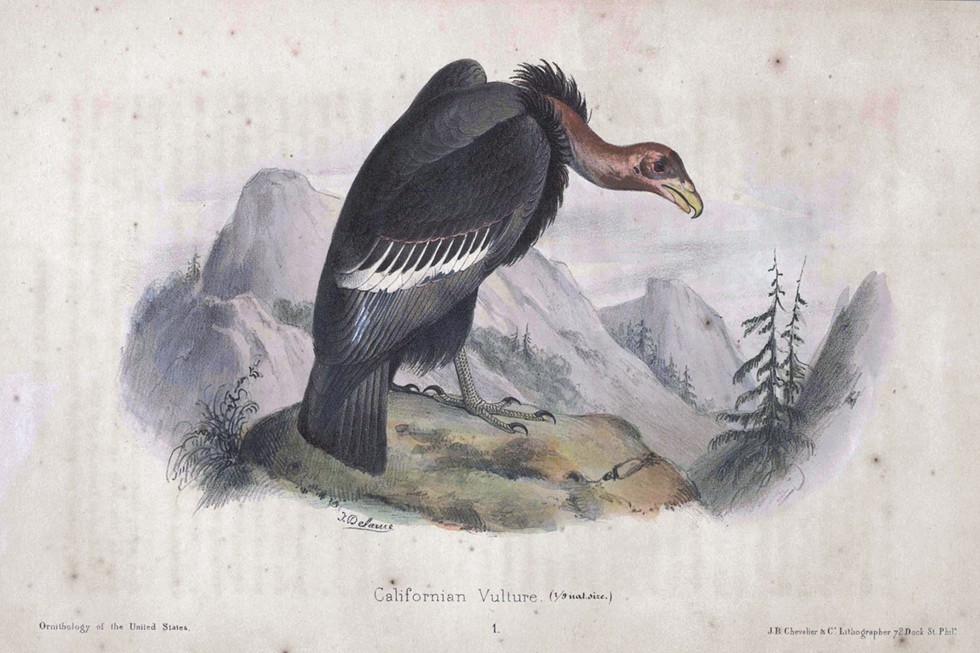
Resident tribal people and early white visitors to our region saw California condors as an integral part of the Pacific Northwest landscape.
The Lewis and Clark Expedition first encountered them at the mouth of the Wind River, just upstream from today's Bonneville Dam, in the fall of 1805. On his rough map of campsites and terrain for that week, Capt. William Clark sketched the head of what he called "the beautifull Buzzard of the columbia." During the expedition's winter at Fort Clatsop, he and Meriwether Lewis described condors gorging energetically around a dead whale on the Oregon beach and tearing at caches of deer meat laid up by their hunters. In mid-February, when two men brought in a wounded condor, Lewis weighed and measured the bird from every possible angle and wrote a close description of the bird. It seems to have been Clark who drew the profile of the condor's head, accurately depicting the strongly hooked beak, prominent eardrum hole and neck feather ruff that clinches their identification.
During the harsh winter of 1825-26, Scottish naturalist David Douglas watched condors feasting on winter-killed livestock at the Hudson Bay Company's Fort Vancouver, across the Columbia from modern Portland.
"I have never seen them call except when fighting about food, when they jump trailing their wings on the ground, crying 'Crup Cra-a,'" Douglas wrote.
Intrigued by the speed at which circling condors appeared on recent carcasses, Douglas and Bay Company agent William Barnston conducted experiments to determine whether the carrion-eaters located prey by sight or by smell, eventually determining that the birds utilized both senses — a conclusion borne out by modern scientific observations.
Barnston later described the simple joy of living with the birds on an everyday basis.
This magnate of the air was ever hovering around, wheeling in successive circles for a time, then changing the wing as if wishing to describe the figure 8... In flight it is the most majestic bird I have ever seen, he wrote.
When Douglas asked tribal people and fur company employees for information about the extent of condor range, one mixed-blood hunter told him that the vultures ventured north to Canada's Fraser River drainage as well as far up the Columbia and Snake rivers. Other hunters described an entire population that frequented the Umpqua country year-round, which Douglas had a chance to confirm when he joined a fur trade brigade for a fall expedition south. In the upper Willamette he witnessed a single group of nine condors and wrote that "Preceding hurricanes or thunderstorms they are at their most numerous and soar the highest."
Douglas also heard that condors constructed stick nests in the thickest parts of the forest and laid two jet-black eggs. In fact, the female condor does not build any nest at all, simply depositing a single pastel-shaded egg on the floor of a cave or cliff ledge. Sometimes, then and now, the lore of condors can be hard to tease apart from fact.
Philadelphia ornithologist John Kirk Townsend, well aware of his peers' previous condor encounters, "kept a sharp look-out for this rare and interesting bird" as he entered the Snake River drainage in 1834. Weeks passed before Townsend finally encountered his first condor wheeling over a crowded tribal fishery at the Falls of the Willamette River, "seemingly intent upon watching the motions of his puny relatives below." When the vulture plunged toward a freshly beached salmon, the naturalist shot it down. The condor fell on the opposite bank of the river, whereupon Townsend stripped off his clothes and swam after his prized specimen.
The hunter made it across to discover that he had only winged his quarry. For the next half hour, much to the delight of a large tribal audience, the naked Townsend parried with the injured condor, pelting it with rocks and sand while the bird "sometimes hobbled awkwardly away, and at others dashed furiously at me, hissing like an angry serpent, and compelled me likewise to run."
Townsend finally clocked the great vulture with a rock to the head and skinned it right there on the sand.
Two months later, he later shot an immature condor at the mouth of the Columbia. Upon his return to Philadelphia in fall 1837, Townsend sold many of his specimens to John James Audubon, who had never traveled across the Continental Divide. Among the last dozen plates that Audubon completed in spring 1838 for his epic "Birds of America" was a painting of a single "California Vulture—Old Male," perched on a bare branch with its neck craning forward. One of Townsend's Columbia River condor specimens almost certainly served as Audubon's model for a credible portrait of a bird that he never saw alive.
The two birds shot by Townsend remain the last recorded wild condor specimens taken from the Pacific Northwest. Although scattered observations from the odd fur trader, railroad surveyor or homesteader dribbled in through the rest of the 19th century, the beautiful buzzard of the Columbia had entered what appeared to be an irreversible death spiral, and the condor that Merriam saw on the ground outside Coulee City in 1897 represented the last generally accepted sighting in Washington state. Oregon's last official record occurred only six years later, when a father and son team familiar with condors spotted a pair flying through heavy weather in the Umpqua drainage.
Those two incidents entered the lore of bird enthusiasts throughout the region as sad but final end points. But are end points ever really as final as we like to declare them? Both those supposed last records came from out-of-state visitors, without allowing the local observers that Merriam so valued to have their say.
Townsend finally clocked the great vulture with a rock to the head and skinned it right there on the sand.
tweet this
One evening a few years ago, I spoke to an audience in Spokane about how Clark, Douglas and Townsend engaged with condors all those years ago. After I finished the last slide and most people had wandered away, a gentleman named Bill Brown introduced himself.
Brown had been born in Oregon in 1915. His father served as a district warden in the Umpqua National Forest between 1930 and 1935. During those Depression years, the teenage Bill spent his summers manning various fire towers in his dad's district.
Brown told me that during his time in those fire towers, he sighted single condors flying on multiple occasions. Often the birds glided below the level of his lookout, allowing for a clear and unobstructed view of their bald heads. From his perch, Brown regularly observed turkey vultures and golden eagles and assured me that the birds he was talking about were much larger. He emphasized that his fellow lookouts were aware of the outsized birds as well: Early radio "phones" connected the network of towers, so the observers could alert one another to the presence and direction of the condors, passing the birds along as they glided from peak to peak.
That evening I brought up the possibility that time had warped Bill Brown's memories, but he answered without taking offense or changing a single detail of his account. I came away from our conversation convinced that he had observed condors plying the same Umpqua country where Douglas had seen them a century before, but 30 years after the birds were supposed to have disappeared from the Northwest entirely.
Brown and I wondered exactly what his experience meant in the context of condor life and extinction. We talked about the concerted captive breeding efforts that had been underway for almost two decades at that point, with decidedly mixed results. Going forward, could living condors ever evolve into anything greater than a curiosity? Brown hoped so.
In the years that followed, as the U.S. Fish and Wildlife Condor Restoration Project gathered steam, I thought a lot about what could make a condor real. I was especially interested in the Inland Northwest, where Merriam recorded his sighting from a morning train.
Language offers one place to begin, because if something as distinct as a condor inhabits a defined area over the course of generations, then a word for the bird will surely follow. That's the way it works moving upstream through the Columbia Gorge, searching the eras before, during and after Euro-American contact.
When Samuel Black, the Hudson's Bay Company agent in charge of Fort Walla Walla in the late 1820s, compiled a basic vocabulary for the three main tribal tongues he heard spoken at the post, he included condor words in Walla Walla, Nez Perce and Cayuse languages. Eugene Hunn, an anthropologist working with Yakama people in the 1970s, recorded different words for condor in two other distinct Sahaptin dialects spoken upstream around the Big Bend.
Farther north on the Columbia Plateau the connection is less clear, but bits and pieces have endured: an Okanogan Salish word for a large bird with white under its wings; a story recorded by an anthropologist working with the St. Mary's band of Kootenai (Ktunaxa) people near Cranbrook, British Columbia, involving a huge raptor that dwarfed all others.
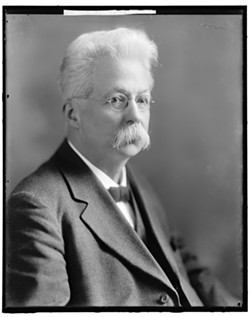
Then there are the body parts. Before the closing of the Columbia River's John Day Dam in 1957, an archaeological excavation at the Five Mile Rapids section of The Dalles uncovered thousands of bird bones in a layer that dated back thousands of years. Among them were no less than 63 individual California condors, the fourth-most common bird in the complex. And the landscape that surrounds these rapids, far from the lush greenery of the lower Columbia Gorge, is classic shrub-steppe.
A recent re-examination of the avian remains from Five Mile Rapids revealed several hundred marks consistent with the action of meat butchering in other birds. The people had applied their knives very differently to the condors, however, cutting distinct swipes across the wing bones that appear to have targeted primary and secondary flight feathers.
Such cut marks might lead directly to an Edward Curtis photo taken in the early 1900s of an elder at Wishram Village. The village site is still located on the Columbia's north bank, hard by the former great fishery at Celilo Falls and only a few riffles upstream from Five Mile Rapids. The elder from Wishram Village holds a gigantic black feather in one hand that could only have come from a condor wing.
Representative art also has to be considered. Wishram Village is also the source for traditional basket patterns studied by weaver Mary Schlick. In the 1970s and '80s, Schlick noticed figures of large birds with outstretched wings on two different flat twined bags. Striking geometric patterns had been laid into the underwings of both birds. When Schlick showed the baskets to elder Nelson Wallulatum, he said that the bird figures represented condors and that the patterns looked like lightning strikes. He said those birds used to live around Celilo Falls and The Dalles. Wallulatum added that not so long ago, people would occasionally capture a young bird.
"They kept a [condor] chick tied in camp to keep away thunder and lightning spirits," he told Schlick.
Even the most compelling oral and written histories can be difficult to prove. Climbers have examined cliff ledges from the Columbia Gorge through Hell's Canyon on the Snake River without finding concrete evidence of condor breeding, and whether condors bred in the Pacific Northwest remains one of the unknown facets of their life history within the region.
Even so, oral accounts of condors, often told long after the fact, seem to have a way of clustering together. The cone of Mount Adams, prominently visible to the north from Celilo Falls, would be easily within reach for a soaring condor sated with fish. The snow-covered peak gives way to green forest and copious lakes that abound with resources long utilized by local people. During one huckleberry picking season in the late 19th century, Yakama tribal member Ellen Saluskin's great-grandfather saw a "huge black bird" that landed and began to devour a half-dressed deer.
"It had eyes like fire," Saluskin said, relating her ancestor's story to a Forest Service archaeologist. "It appeared enormous. Its beak was long and yellow, and it was constantly opening and shutting its beak."
Talking to basket weaver Mary Schlick in a different place and time, Saluskin shared almost the same story: at Lake Sahalee Tyee, her grandfather killed a condor attracted by a partially butchered elk. After that encounter, Suluskin's grandfather carried a condor tail-feather as talisman the rest of his life. Lake Sahalee Tyee is located inside the Indian Heaven Wilderness, not far off the western flank of Mount Adams.
In the 1980s, Lila Walawitsa, who lived on what was then called the Yakima Reservation, told Hunn that in the 1890s her father saw a pach'anahúy (condor) at Potato Hill, just north of Mount Adams.
Josephine Andrews was a child in the 1920s when she first saw what she termed a pachanahoo or canahóo — two separate Sahaptin words for condor — at Howard Lake, northwest of Mount Adams and quite close to Potato Hill. When she was in her late 20s during World War II, Andrews saw another bird on the ground near the same location.
"Grandmother was living; we were all camping at Howard Lake. Jim Kwiyal and Otis Shiloh saw it," she described. This second bird was "bald headed, like a turkey but smoother; like k'shpali (turkey vulture)" The bird Andrews saw was "much bigger than k'shpalí but almost the same; black and brown; with no white on wing; sitting on horse, he could look you in eye standing." Andrews' description fits that of an immature California condor and harks back to Merriam's vision of his standing condor outside Coulee City.
Directly south of Celilo Falls, Mount Jefferson presents another snow-capped lure. Early one summer day in the 1950s, as Wasco tribal member Ken Kachie Smith walked along the slopes of Jefferson on the Warm Springs Reservation, he was stunned to encounter three California condors at close range. "Each was perched on a different limb" of a large snag 150 feet away.
After seeing the condors, Smith came upon a winter-killed elk in a snowbank on a north-facing slope. A flock of ravens, three bald eagles and two golden eagles were feeding on the carcass. Several turkey vultures were also present. Smith noted the condors' large size, bald heads and bare necks. He specifically stated that they were different from the turkey vultures.
But condors can fly so much farther. Catching afternoon thermals, a bird could follow the Columbia's main stem all the way around the Big Bend to the river's confluence with the Okanogan. That is where Jackie Cook, growing up in a big family in the southwest corner of the Confederated Colville Tribes Reservation, first heard her condor story.
Cook's mother told her that back in the 1940s and '50s, before Chief Joseph Dam was built, her dad used to work for a neighbor as a cowboy, tracking free-range cattle. He often rode the stretch between the Okanogan and Grand Coulee Dam, where he could watch both golden and bald eagles in all their varieties of plumage, as well as turkey vultures during the summer months.
After one early fall stint in the Box Canyon area, Cook's father came home saying that he had seen a different bird, much larger than the familiar eagles. This bird was flying in close circles, and he was able to watch it for a long time, taking careful note of what made it appear so different. The family kept a good picture dictionary at home, so he and Cook's mother systematically looked up all the possible birds the father might have encountered. As soon as he saw the condor, her dad said, "That's it — that's what I saw."
Alternatively, condors riding the wind could follow the Snake River, which bends south at the Washington-Idaho border. Those birds would glide over Hells Canyon and the Seven Devils Wilderness, a world of precipitous cliffs. This is Nez Perce country, and the tribe has both a word in their language for condor and stories that Hells Canyon and the surrounding mountains used to be the place to find them.
The course of the Snake emerges from its great canyon and curves east, where our story circles back to one of the last generally accepted sight records — as least as far as white recorders are concerned — for the state of Idaho.
In a biographical sketch, Gen. T.E. Wilcox, a retired U.S. Army officer who once ran sheep in the Boise Basin, asserted that in the fall of 1879, while patrolling his flock near the hot springs above Boise City, he had come upon "Two California vultures... feeding on the carcass of a sheep. They hissed at me and ran along the ground for some distance before they were able to rise in flight. They were much larger than turkey buzzards, with which I was quite familiar, and I was very close to them so that I could not be mistaken in their identity. The cattle-men said that the California vulture or buzzard was not uncommon there before they began to poison carcasses to kill wolves."
Wilcox here presents clear details of an outsized bird doing exactly what condors are supposed to do, in territory that Douglas heard lay within their range. In addition, Wilcox provides a particular detail that no tribal source mentions, and that may well hold the key to the condor's inexorable decline: Cattlemen were lacing dead animals with strychnine for the express purpose of killing wolves. If you want to hurt a carrion eater, there can be no more effective tool than poisoning dead meat.
It had eyes like fire. It appeared enormous. Its beak was long and yellow, and it was constantly opening and shutting its beak.
tweet this
Condors, wolves and salmon. Three totems that evoke the spirit of the Northwest, their fates linked with humans on so many levels. And we might as well include the American buffalo with them, the foremost symbol of the Great Plains, because condors interacted with them as well.
In the 1930s, anthropologist Claude Schaeffer, working out of the Blackfoot Reservation in Browning, Montana, read about an ornithologist who had sighted a pair of condors in the Bow River Valley near Calgary in 1896 — only a year removed from Merriam's Coulee City record. Building off that clue, Schaeffer transcribed a remarkable series of oral accounts that span the East Front of the Rockies from Alberta to Montana.
These prairie accounts include language, art and body parts that mirror the Columbia Plateau sightings. Dog Takes a Gun held a 2-foot-long tail feather in his hands. Cree people from the Hobbema Reserve south of Edmonton kept a skinned condor cape that, when draped from a grown man's head, dragged to the ground. Chewing Back Bones recalled a raid into Crow territory in southern Montana called off because of the appearance of a condor circling their horses. Yellow Kidney described a bird of extraordinary size with white under its wings and a large, hooked beak that shaded from dark blue to yellow at its base. He said that in former times these birds had been attracted to the offal left behind from buffalo hunts.
Jack Nisbet will be talking more about condors at Othello's Sandhill Crane Festival on Saturday, March 25. For more details, visit www.othellosandhillcranefestival.org.
These four totem species ran afoul of white settlement for very different reasons. After almost destroying each one of them, people decided that they wanted their totems back, often not accounting for what might come along with the bargain.
Salmon, caught and dammed to a fraction of their original numbers, ask an exceedingly high price for anything like a reasonable return. Wolves, poisoned and hunted to virtual extinction before World War II, have come back to affect several ecological equations formulated in their absence. Buffalo graze in large numbers, but the genetics of most herds remains intertwined with domestic cattle. The last wild condors, fading like ghosts in Southern California's Sespe Reserve, were scooped up from the wild to form the core of a captive breeding program that will soon be half a century old.
Perhaps we should expand our sense of time to think about these elements. Condors fed on the carcasses of large herding mammals during the last Ice Age. As the climate warmed, extreme weather cycles surely decimated their prey base and altered their life history on several occasions, yet the beautiful buzzards found enough food to survive through more than 15,000 years of change. During all that time, they shared their bounty with people: camping beside stranded marine mammals on ocean beaches, harvesting salmon at fisheries located around river blockages, tracking great herds of buffalo across rolling prairies. What is 200 years against time counted in millennia? How does a concrete dam compare to a 2,000-foot wall of ice? Who gets to decide what the concept of wildness means in today's Inland Northwest?
The future of condors remains very unclear at the moment. It's a difficult proposition for a large carrion-eater to survive in the face of drastic change, much less to thrive as a free-wheeling magnate of the air. At the same time, creatures and species exposed to the face of death often show an extreme reluctance to let go of the essential spark of life. Given the condors' long track record, I'm not sure I'd bet against them. ♦
Spokane-based writer Jack Nisbet has explored Pacific Northwest condors in two different books: Visible Bones and his forthcoming The Language of Birds. The sources for all the above condor sightings can be found in those essays or in Brian E. Sharp, "The California Condor in Northwestern North America." Western Birds volume 43, number 2 (2012).
MOUNTING A CONDOR
When the Northwest Museum of Arts and Culture undertook an exhibit about condor enthusiast David Douglas a decade ago, a replica bird seemed like a natural addition. A determined curator at the University of Washington's Burke Museum obtained permission to stuff the frozen carcass of specimen No. 431, a captive release condor that had died of lead poisoning in the wild. The curator then convinced renowned taxidermist Igor Carogodin to tackle the restoration.
A meticulous researcher, Carogodin prepared for his task by combing archives for information about condor plumage succession as well as beak, head and foot color in different age classes. He studied every photo and video he could find on the internet. At the first opportunity, he traveled to the Grand Canyon to watch the flight mechanics of successfully released birds.
What Carogodin could not prepare for was the way lab technicians had to remove a large chunk of muscle and bone from condor No. 431 for their necropsy. That forced him to spend many hours sculpting clay into a body shape before facing the aesthetic considerations that would bring the bird back to life.
To create a secure mount in a realistic posture, Carogodin welded a threaded bolt into the back of his sculpted body. He draped the carefully flensed skin around this base like a cloak and sewed it closed with tiny invisible stitches. He airbrushed a conservative shade of orange-red onto the naked head. He bandaged the wings and feet into a dramatic turning position, then carefully combed out all the loose feathers right down to the distinctive neck ruff. After a nerve-racking month to make sure the creation was completely dry, Igor Carogodin's condor mount arrived in Spokane just in time for the opening of the David Douglas exhibit.
There the beautiful buzzard of the Columbia soared again, with the adult's lightning-strike black and white pattern clearly visible on the underside of wings that spanned almost 10 feet from tip to tip. Children entering the exhibit could peer over a pair of separating walls and catch a glimpse of the bird's primary flight feathers, stretched wide like fingers to catch the slightest breeze. A small but steady percentage of those kids left their group behind to spend their hour directly below the feet of the great vulture. Today, people young and old still surround Carogodin's condor mount at the new Burke Museum on the UW campus. It's worth a visit.
— JACK NISBET

